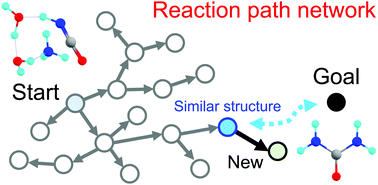Leveraging algorithmic search in quantum chemical reaction path finding†
Abstract
Reaction path finding methods construct a graph connecting reactants and products in a quantum chemical energy landscape. They are useful in elucidating various reactions and provide footsteps for designing new reactions. Their enormous computational cost, however, limits their application to relatively simple reactions. This paper engages in accelerating reaction path finding by introducing the principles of algorithmic search. A new method called RRT/SC-AFIR is devised by combining rapidly exploring random tree (RRT) and single component artificial force induced reaction (SC-AFIR). Using 96 cores, our method succeeded in constructing a reaction graph for Fritsch–Buttenberg–Wiechell rearrangement within a time limit of 3 days, while the conventional methods could not. Our results illustrate that the algorithm theory provides refreshing and beneficial viewpoints on quantum chemical methodologies.



 Please wait while we load your content...
Please wait while we load your content...